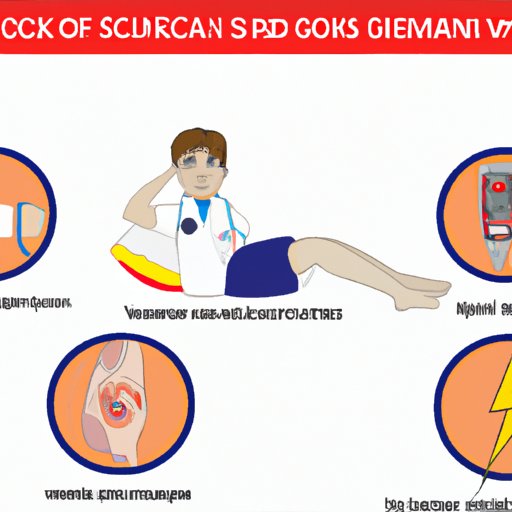
I. Introduction
Shock is a medical emergency that happens when there is a lack of blood and oxygen circulation in the body. Shock can be life-threatening if left untreated or not recognized promptly. It’s essential to understand the symptoms of shock and know-how to recognize them to take immediate action. This article provides a comprehensive guide to identifying symptoms of shock and how to address them.
II. The 7 Common Symptoms of Shock You Should Know About
The seven most common symptoms of shock include:
- Cool, clammy skin
- Rapid breathing or shortness of breath
- Rapid heartbeat
- Dizziness or lightheadedness
- Confusion or disorientation
- A weak pulse
- Bluish lips and fingernails
These symptoms occur when the body is not getting enough blood and oxygen, which can happen due to various reasons, including trauma, illness, or severe infection.
III. Recognizing Shock: An Overview of Symptoms to Watch for
Let’s take a closer look at the symptoms of shock that you should keep an eye on:
Cool, Clammy Skin
One of the most apparent signs of shock is cool and clammy skin. Inadequate blood circulation to the skin can cause it to become pale or grayish and be cold or moist to the touch. This is because blood flow is prioritized to vital organs like the heart and lungs when the body is in shock, causing the skin to feel clammy and appear pale.
Rapid Breathing or Shortness of Breath
When the body experiences shock, it tries to compensate by increasing breathing rate to supply more oxygen to the body. This can cause rapid breathing or shortness of breath. If you notice someone who is experiencing these symptoms, it’s essential to get them medical attention right away.
Rapid Heartbeat
The heart pumps blood throughout the body, and when it senses there’s a lack of blood and oxygen circulation, it increases the heart rate to compensate for the lack of oxygen. An elevated heart rate can be a clear sign of shock.
Dizziness or Lightheadedness
A person experiencing shock may feel dizzy or lightheaded, which can happen because the body is trying to preserve blood flow to the brain. This can cause a feeling of unsteadiness and general disorientation.
Confusion or Disorientation
The lack of oxygen circulation can affect the brain, making it challenging to think and focus. Confusion and disorientation are common symptoms of shock and can be a sign that the body is in a life-threatening condition.
A Weak Pulse
As the body tries to compensate for the lack of blood circulation, the heart may struggle to pump blood efficiently. This can cause a weak pulse, indicating a potentially life-threatening situation.
Bluish Lips and Fingernails
Cyanosis, a bluish discoloration of the skin and mucous membranes, can be an indication of a lack of oxygen in the body. Cyanosis of the lips and fingernails can be a clear sign of shock and should be addressed immediately.
IV. How to Spot Shock: 7 Signs to Look for
Shock is a common occurrence in emergency situations, so it’s crucial to know how to spot the signs. Here are some potential symptoms of shock in emergency situations:
Excessive Bleeding
Severe blood loss can lead to shock. It’s essential to apply pressure to the wound and try to stop the bleeding immediately.
Chest Pain
Chest pain can be an indication of a heart attack, which can lead to shock. Rapid medical attention is necessary to prevent further complications.
Head Injury
Ahead injury can cause swelling in the brain, leading to shock. It’s important to seek medical attention immediately to prevent further damage.
Severe Allergic Reaction
A severe allergic reaction can lead to anaphylactic shock, a life-threatening condition that requires immediate medical attention.
Burns
Burns are a severe injury that can cause shock. It’s essential to treat the burns quickly to prevent further complications.
Electrical Injury
Electrical injuries can cause significant damage to the body, leading to shock. Seeking medical help immediately is necessary to prevent further complications.
Poisoning
Poisoning can lead to shock, which requires immediate medical attention to prevent further complications.
V. The Ultimate Guide to Identifying Symptoms of Shock
Let’s take a closer look at some patient examples to highlight the experience of shock, including these common and lesser-known symptoms:
Feeling Weak or Faint
Feeling weak or faint is a common symptom of shock that occurs due to a lack of oxygen circulation to the brain.
Anxiety or Restlessness
Feeling anxious or restless can be a sign of shock as it indicates the body is trying to compensate for the lack of oxygen and blood circulation.
Nausea or Vomiting
Nausea or vomiting can be a symptom of shock, indicating that there’s not enough blood flow to the digestive system.
Decreased Urine Output
The kidneys are responsible for filtering blood and producing urine. During shock, the inadequate blood flow to the kidneys can lead to decreased urine output, which can be a clear sign of shock.
Lethargy or Fatigue
The lack of oxygen and blood circulation can lead to a feeling of lethargy or fatigue, which can be a symptom of shock.
It’s crucial to recognize the symptoms of shock as they can be life-threatening if left untreated. Identifying symptoms promptly can improve the chances of survival and proper treatment.
VI. When Your Body Goes into Shock: Identifying its Symptoms
Understanding the stages of shock can help identify its symptoms. Shock happens in three stages:
Stage 1 – Initial Stage
The body’s initial response to shock includes increased heart rate, constricted blood vessels, and increased breathing.
Stage 2 – The Compensatory Stage
The body tries to compensate for the lack of blood and oxygen circulation in the second stage of shock. Symptoms include cool, clammy skin, anxiety, decreased urine output, and rapid breathing or shortness of breath.
Stage 3 – The Progressive Stage
The third stage of shock is the most severe, and the body’s compensatory mechanisms start to fail. Symptoms can include weak or absent pulse, slow breathing, confusion, and organ failure.
Recognizing the symptoms of shock can differ depending on the age group one is looking for.
Infants
Infants can experience shock due to infections, blockages of the airway, or severe dehydration. Symptoms in infants include fussiness, reduced wet diapers, sunken fontanelles, and listlessness.
Adults
In adults, symptoms of shock are similar to those listed above, such as cool, clammy skin and confusion, but may also include a sudden drop in blood pressure.
Elderly People
Elderly people can experience shock as a result of chronic disease, such as heart disease or diabetes. Symptoms of shock in the elderly can include a sudden change in mental status, reduced urine output, or a decrease in body temperature.
It’s important to take preventative measures to avoid shock. This includes staying hydrated, eating a healthy diet, and taking steps to reduce the risk of falls or accidents.

VII. Symptoms of Shock Explained: Understanding Emergency Medicine
From a medical perspective, shock is a life-threatening emergency that requires quick and prompt treatment. Treatment can vary depending on the severity of the condition but commonly involves fluids, medications, blood transfusions, or surgery.
There are several causes of shock, including trauma, severe blood loss, severe infections, heart attacks, or severe allergic reactions. The biological effects of shock include decreased blood flow to organs, which can lead to organ failure in severe cases.
Preventative measures, such as staying hydrated, avoiding allergens, and taking appropriate safety measures accompanying exercises or sports, could reduce the risk of shock.
VIII. Don’t Ignore the Signs: Identifying Symptoms of Shock and Taking Action
The symptoms of shock can be life-threatening and should not be ignored. Recognizing these symptoms promptly and taking action can improve the chances of survival and proper treatment.
If you suspect someone is in shock, dial emergency services immediately. Make sure they’re lying down, elevate their legs, and cover them with a blanket. Do not give them anything to eat or drink unless instructed by a medical professional.
It’s important to take the information provided in this article seriously and apply it to your life, including making sure you stay adequately hydrated, managing chronic health conditions, and following proper safety precautions.
IX. Conclusion
Shock is a life-threatening condition that can happen to anyone. Knowing how to recognize its symptoms and how to take immediate action is essential to improve survival chances and proper treatment. Remember to dial emergency services at signs of shock, and always take preventative measures to avoid it.




